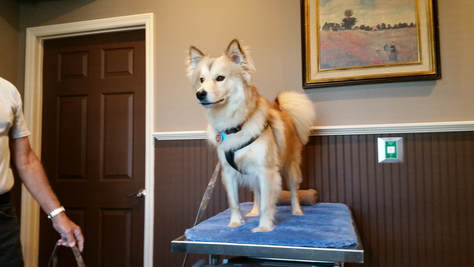|
We knew Rusty was heartworm positive when we adopted him from the Pell City Animal Shelter on September 19, 2017. We were told it was a “light positive,” but since heartworms are heartworms, the number of worms did not matter. Rusty had a number of behavioral issues to overcome and the fact that he was heartworm positive just added one more aspect to his rehabilitation. I'm sharing the story of his treatment in hopes that you will learn something from it. If your dog is not already on a monthly heartworm preventative – which costs about $50 to $70 a year to administer – I implore you to start that treatment now. 1 Diagnosis (Heartworm Basics) The Disease. According to the Heartworm Society, “heartworm disease is a serious and potentially fatal disease in pets in the United States and many other parts of the world. It is caused by foot-long worms (heartworms) that live in the heart, lungs and associated blood vessels of affected pets, causing severe lung disease, heart failure and damage to other organs in the body. Heartworm disease affects dogs, cats and ferrets, but heartworms also live in other mammal species. The disease can only be spread between pets by mosquitoes.” Dogs are considered natural hosts for heartworms, which means that heartworms that live inside the dog mature into adults, mate and produce offspring. If untreated, their numbers can increase. Dogs have been known to harbor several hundred worms in their bodies which causes lasting damage to the heart, lungs and arteries and which can affect the dog’s health and quality of life long after the parasites are gone. Heartworm disease in cats is very different from heartworm disease in dogs. The cat is an atypical host for heartworms and most worms in cats do not survive to the adult stage. Cats with adult heartworms typically have just one to three worms, and many cats affected by heartworms have no adult worms. Prevalance. Your community may have a greater incidence of heartworm disease than you realize—or you may unknowingly travel with your pet to an area where heartworms are more common. Heartworm disease is also spreading to new regions of the country each year. The fact is that heartworm disease has been diagnosed in all 50 states, and risk factors are impossible to predict. Multiple variables, from climate variations to the presence of wildlife carriers, cause rates of infections to vary dramatically from year to year—even within communities. And because infected mosquitoes can come inside, both outdoor and indoor pets are at risk. Our veterinarian told us that dogs in our area have about at 50% chance of being bitten by a mosquito carrying heartworms in his or her lifetime. Treatment. Once a dog is diagnosed with heartworm disease, he or she normally begins treatment with a course of antibiotics, heartworm preventives and steroids before beginning the actual adult worm treatment. The actual treatment for heartworm disease consists of three shots of an organic arsenical compound that is injected into the dog's lumbar, or back, muscles. There is only one FDA approved drug for this. The dog is retested after treatment and six months later to ensure that all of the larvae, microfilariae and adult worms are dead. Dogs who remain heartworm positive six months after treatment may need to repeat treatment to kill the remaining worms. 3 Shots For the first 8 months with us, Rusty took a heartworm preventive once a month and he continues that regimen to this day. In anticipation of his actual heartworm treatment, he took an antibiotic and a steroid for a month starting in early June and ending in early July. He was not allowed to chew the medication so pill pockets were out; Rich handled the daily task of putting the medication down Rusty's throat. The first of Rusty's three heartworm shots was on August 8, 2018, and so began our long road of treatment. Our veterinarian shaved the fur off of his back to do the injection which was placed close to his spine. The first shot was to kill the female worms. The shot itself did not take long and we were told to walk him around the parking lot for five minutes to get the drugs circulating. We did and then we took him home to begin one of the worst days of his life. He had a terrible time getting comfortable and had difficulty walking. It took about 3 hours before he could be in one position for more than about 5 minutes. The second shot was a month after the first and the third shot was a day after the second shot. These shots were to destroy the male worms. Like the first shot, these shots were administered near Rusty's spine and he had difficulty moving and getting comfortable for a period of hours. After the third shot, he had a visibly swollen area on his back which stayed there for weeks. 10 Weeks Other than the shots themselves, the most difficult part of the treatment is the weeks following the shots. In our case, Rusty had to remain calm for a total of approximately 10 weeks. His first shot was August 8, 2018 and his third shot was September 8, 2018. From the date of his first shot, Rusty's activity had to be drastically limited to keep his heart rate from elevating. This could have proven to be fatal. After each of the shots, there was a 2 week window of time which our veterinairan called the "danger window" of time during which the worms would be leaving Rusty's body. It was vital during this time that he remain as inactive as possible. Unlike intestinal parasites which can be passed in the animal's stool once they are killed, heartworms do not have an easy way to be eliminated from the body. The dog's immune system must break down the dead worms, an elimination process which is very effective but which takes times. While that immune process is taking place, fragments of dead heartworms are circulating in the blood stream. These fragments can cause a multitude of problems, the most common of which is physical obstruction of blood flow to the lungs. Because of this and other risks, dogs undergoing heartworm treatment must be kept calm and quiet, without any rigorous exercise or boisterous play. Studies have shown that most of the dogs that die after heartworm treatment do so because the owners let them exercise. It’s not due to the drug itself. Keeping a young dog quiet for 10 weeks was a challenge. We crate trained Rusty from the time we brought him home and that helped immensely during his heartworm treatment. We call his crate his room and he is in it regularly just to rest. He could have limited toys which he played with himself but we did not play with him inside or outside. If he got a little too wound up, he went to his “room” (as in “go to your room”) to calm down. He went outside only to relieve himself and for very short walks. He was always leashed, even inside his fully fenced outdoor play area, and we had to check the area around our property before taking him out to make sure there were no other dogs or cats he could see which would raise his heart rate. Truth be told, my husband bore the brunt of this work. Ten weeks may not seem like a long time, but it is when the focus of each day is keeping a 2 year old dog who wants to run and play calm. Rusty's 10 week crate rest period ended on Sunday, October 21, 2018. We celebrated with the sudden discovery of a lot of toys (his old toys which had been hidden in a closet for more than two months) a long truck ride, a walk by Lake Guntersville and just a little bit of ice cream from Dairy Queen. 9 Months Although Rusty's treatment is over, the process is not yet completed. He will need to be heartworm tested again in May of next year to confirm that the heartworms are gone . Our veterinarian told us the antigens can remain in his blood stream for months so testing now would not do any good. He will continue to get heartworm preventative every month and we'll just pray he tests negative in May so he doesn't have to go through the process again. He will need to be tested annually the rest of his life. 70 Dollars I have heard people say in my area (Alabama) that they don't give their dogs heartworm preventative treatment. Some say it's not necessary. Others say it costs too much. I consider this a form of neglect. The cost to give a dog under 25 lbs. preventive treatment is about $48 a year. For a dog between 25 and 50 lb.s, it's about $66 a year. For a dog above 50 lb.s, it's about $74 a year. This depends on the brand you use ; the most common choices are Heartguard and Interceptor (which we use on recommendation of our veterinarian), but there are other brands available. Rusty's heartworm preventative is $70 which boils down to aout $6 a month. If your dog is not worth this amount of money to you, please don't have a dog in your life. If you are homeless or having difficulty affording the preventative, please contact a rescue group near you to ask if they will help you provided this vital treatment to your dog and please get your dog tested annually. (images and some content courtesy of the Heartworm Society; bottom image courtesy of Perrin-410 Animal Hospital)
0 Comments
|
AuthorI am an animal welfare advocate. My goal is to help people understand some basic issues related to companion animals in America. Awareness leads to education leads to action leads to change. Archives
July 2024
Categories
All
image courtesy of Terrah Johnson
|





 RSS Feed
RSS Feed